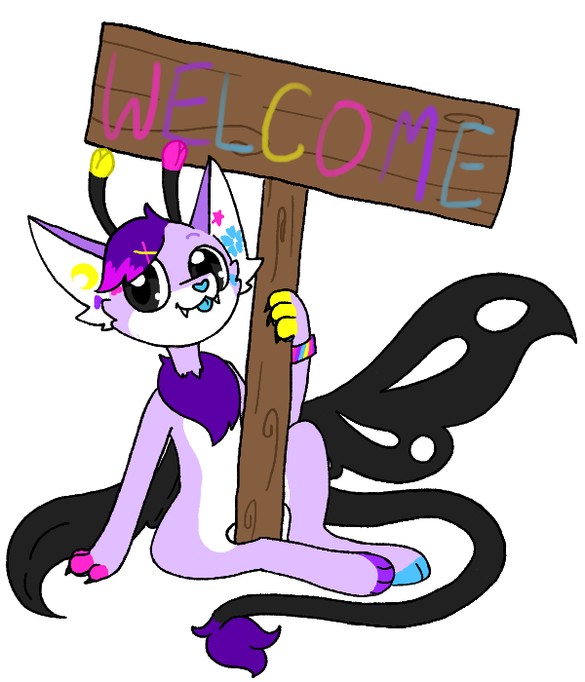
Welcome to the keicoe forest! This site will provide you with everything you need to know about keicoe fairies! Information is divided up into sections for your reading pleasure! They are an open species created by Hiilumaru (dA, fA, tumblr, toyhouse etc), so anyone who wants to can make one!
Anatomy
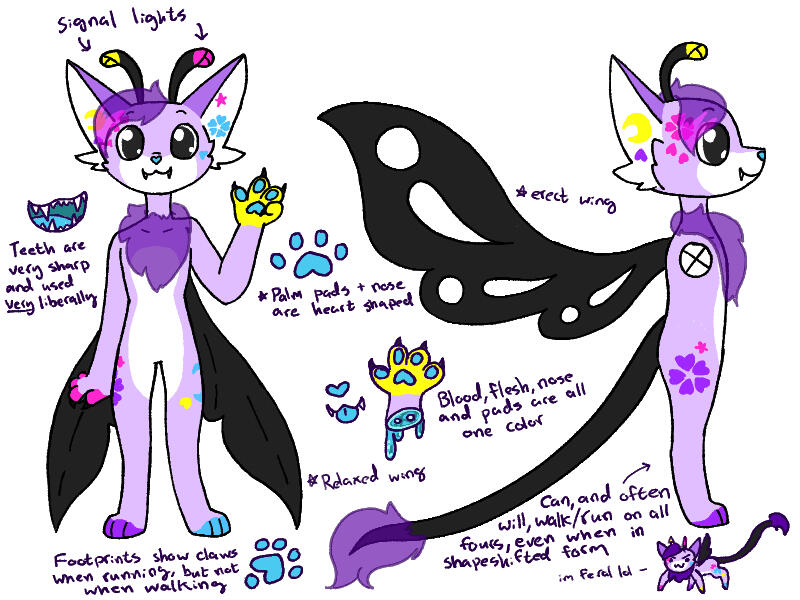
Average height: 3'4"
Average weight: ~30lbs
Lifespan: Around 160 years
Diet: Meat, fruit, fungi, fish, flowers
Birthrate: One litter (two to four kits) every 15 years on average
Waking hours: Dusk to dawn
Keicoe fairies are small animal fairy furries who typically only grow up to about three feet in height. Each fairy has a pair of wings, a pair of antennae or horns, a long, naked tail and a mane, but beyond that, they're known for their wildly unique looks. Their fur and skin come in endless colors, and their features can vary widely form fairy to fairy; even their signal lights are different colors, and symmetry is uncommon, even in lights and eye colors. They have very little sexual dymorphism, so individuals are distinguished by their colors, not their gender, and many use gender-neutral or neopronouns.
Senses
Keicoe fairies are nocturnal, and as such, they have sharp night vision and senses. Their hearing and sense of smell are better than a normal furry's, and they also have a special extra sense; They can "read" the signal lights of other fairies. Though the flashing patterns of their lights are obvious to everyone - making some associate them with fireflies - they can tell a left signal from a right signal, regardless of the color of the lights or the direction the other fairy is facing, so the messages the lights send can be very complex even at a distance.
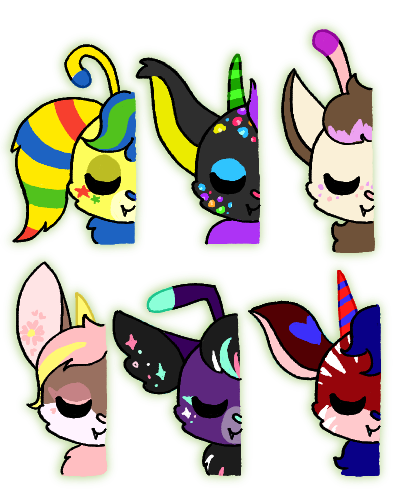
Antennae
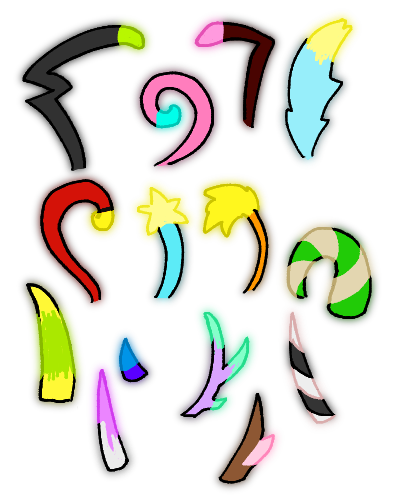
The "antennae" of a keicoe fairy may sometimes resemble those of insects. However, their only function is to hold their signal lights. Because of this, they can come in many different shapes that fall into two categories; Antennae and horns. Antennae are typically longer and fleshy like their wings, able to move, and are used like the ears when making facial expressions. Horns are hard like bone and can't move, but can sometimes have interesting light organ formations that form patterns - or even light the entire horn - where antennae only glow at the tips.
Wings
The wings of keicoe fairies come in all kinds of strange shapes. They're made entirely of powerful muscle, and often have natural holes in them that don't seem to interfere with flying. Because of their strength and flexibility, keicoe fairies often use their wings as an extra set of hands. Some can also be used as weapons, as the pointed corners of the wings' geometry are very hard and sharp when stiffened for flying.
Though their wings can seem unwieldy, they can stretch and bend very easily, and the holes in their wings are easy to manipulate and open or close at will. Because of this, even large and broad wings can be stretched thinner to take up less space when the fairy isn't flying.
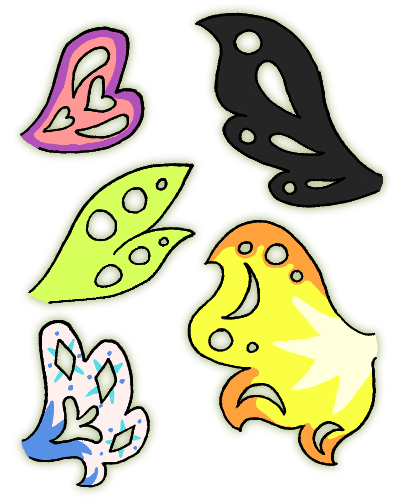
Tails
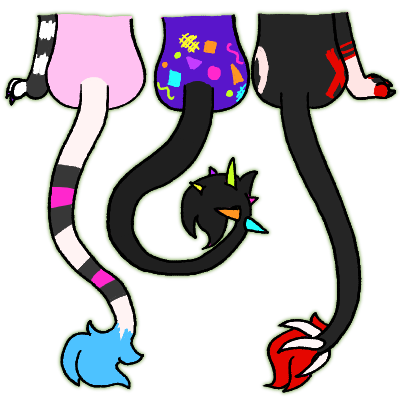
The tail of a keicoe fairy is essentially an extra arm. They're very long, flexible and strong, to the point where a fairy can hang upside down by their tail like an opossum. Most fairies have a tuft at the end of their otherwise naked tail, however, some can have "thorns" made out of the same material as their horns. Some fairies also don't have tail tufts, sometimes having balls of thorns or "thorns" in shapes that match their markings instead, though they will never have a totally bare tail with neither.
Markings
Keicoe fairy markings are their most notable feature. They are very colorful, with bold patterns accenting a widely varying palette. Some look fairly coordinated, and some look like clown vomit. What remains the same through all fairies, though, is that any fairy has a minimum of four colors on their bodies. The only color rarely seen is grey; black and white are quite common, but grey is very rare.

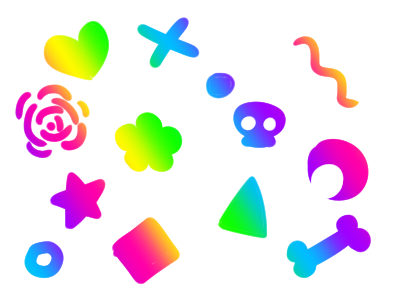
The markings themselves can take symbolism from anything. Most commonly are insects and plants, but also commonly seen are modernly stylized shapes like stars, hearts, moons and suns. Squares and circles and other perfect geometric shapes also appear somewhat frequently, as do random squiggles and blotches that seemingly have no meaning. There's really no limit to the markings that can occur.
Despite the potential for any kind of pattern, keicoe fairies do have a little semblance of order in their appearance. Their markings are divided into three categories; Coat, band, and pattern. The coat is the plain color under all the other markings, where muzzle and belly patches will be found, and can also include the patterns of other animals, like tiger stripes or leopard spots. Bands are the markings at the extremities, like socks, leg stripes, colored toes and hair streaks. Patterns are the shaped markings, like spots, stars, flowers and such. Pattern markings appear in a handful as accents, at the corners of eyes, on hips, inside ears, but don't dominate the entire body like coat markings.
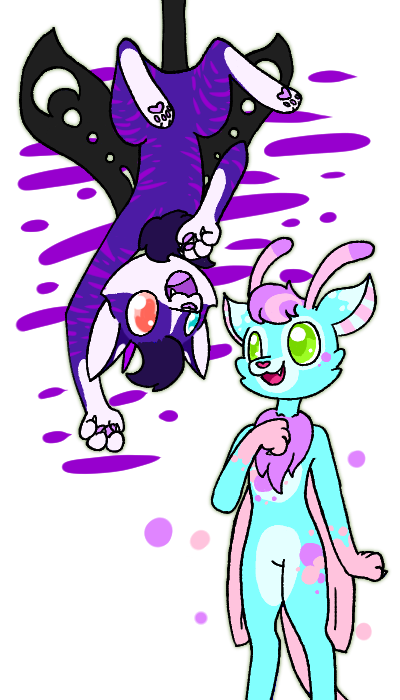
Reproduction
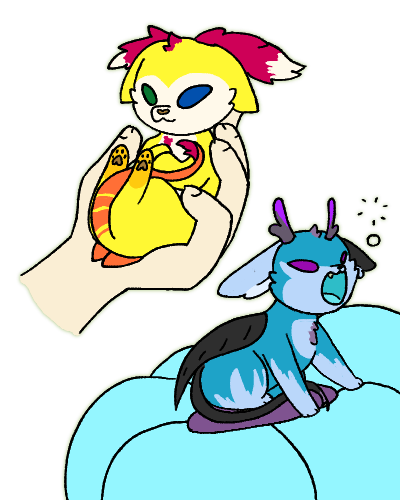
Keicoe fairies can reproduce like any other animal; there are males and females, and they can mate and have kits like any mammal does. However, that's not the only way keicoe fairies are made. The magical influence of the fairies can make forests enchanted, and forests laden with negative energy can become cursed in the same way. People often become lost in these cursed forests. When children die in places like this, underneath the trees, a bud grows from their bodies and a newborn fairy bursts out, following the traces of other fairies back to their communes where any fairy who wants them will happily take them in and raise them as their own.
Bud kits mature differently than regular kits, growing rapidly to match the age at which they died over several weeks or months before their growth slows back to normal. At the equivalent of around eight to ten years old, they start to recall their past life, and they might notice that some of their markings correspond to injuries they had when they died; some might even have a marking representing the injury that killed them.
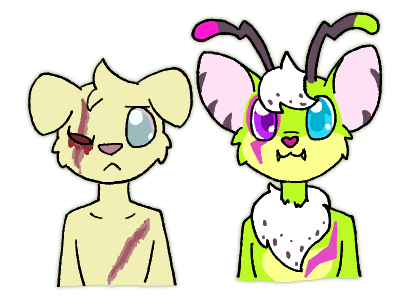
Behavior
Keicoe fairies live together in large colonies called communes. Because of this, they're very social creatures, with other fairies and with regular furries who they find interesting.
Disposition
Naturally, being a kind of fae, keicoe fairies are no less intelligent than other furries. They're very clever, and unlike most fae of myth, talking to one isn't an invitation for mischief. Most fairies, if given a reason to talk to regular furries, are usually very friendly and polite, and also very empathetic. They can also, however, have a mean streak just like the more malicious fae; getting travelers lost - especially ones who offend them - is commonplace, and it isn't unheard of for fairy kits to lure the furry friends they make into the woods to become fairies themselves. They can be helpful or malicious, and most fairies are some mix of both.
Hunting and foraging
Keicoe fairies are omnivorous. Individual fairies can have a widely varying taste in food, though most will prefer to forage rather than hunt. However, they are capable of taking down prey much larger than them, as well as animals who would typically prey on something their size, due to their advantages of intelligence and flight. Most fairies don't even hunt with weapons, instead using their teeth, wings and claws to fight their prey head on. Foraging is a task often left to commune kits while adults hunt; the magically enhanced forests where keicoe fairies live tend to be rich in equally enchanted plants and animals, providing everything from insects to fish to fruit to fungi for them to sniff out and collect. With their animal senses, keicoe fairies are remarkable at foraging, able to sniff out fruits, roots and mushrooms with ease, even in places where they are unfamiliar with the local flora. This ability proves helpful, as fairies in search of furry currency can easily find and sell very valuable and rare produce that may be harder to locate in areas outside their naturally varied groves.
Communes
Fairy colonies are typically small villages - or communes - in clusters of up to ten. There can be anywhere from ten to sixty fairies in a commune, enough for their small-scale villages to look quite busy at night. There are a few basic commodities that all colonies have; a small market, a food stock, and most also have a library of family histories. The communes themselves have little more than family homes and the odd shop providing a service or goods. Colonies typically function like small towns, and each commune within a colony will likely have something that they provide to the others, as keicoe fairies are inclined to help out their communities in any way they can.
Most fairies live with close friends in tree houses of their own construction. Though fairies typically know most of the members of their commune at least by name, they have a close group that is essentially their family as opposed to living with their actual blood relatives; adoption is very common in keicoe fairy society, and it's not uncommon for a couple to have an unexpectedly large litter only to give away some of their kits to family or friends who want them. In the same vein, kits born from buds are usually snatched up within hours of making their way to a commune, to quickly find themselves in a home with a family as if they had been born alongside the parents' own kits. Keicoe fairy society doesn't see blood as anything more significant than close personal bonds, so once a fairy can decide who they want to live with, it's not unusual for young kits to build their own dens with their friends and live together, continuing to do this into adulthood.
Social
Keicoe fairies typically don't travel alone. In areas where they may be present, people are warned to travel with caution; It's commonly believed that if one fairy is spotted, there's likely ten more in the surrounding woods. They communicate with signals as much as they do verbally, so communes often look like they're lit up with christmas lights. Though fairies don't typically travel in as large of numbers as people think, they will always be in groups of two or more when found, with the exception of unusually bold fairies who aren't afraid to snoop around furry society where most fairies won't wander.
Keicoe fairies can speak most furry languages, though they usually have some kind of speech impediment when trying to speak with furries and some languages may be difficult for them. Their native language sounds more like raccoon, fox or coyote noises, consisting of barks, chitters, howls, trills and whistles. Their laughs, though, sound like they belong to a small child, and can easily spook hikers wandering into their territory.
Typically shy, keicoe fairies don't often show themselves to furries unless they're in disguise. However, they are quite curious, and can be bribed into conversation with sweets. Kits are a bit more bold, and it isn't uncommon for them to befriend furry children under the guise of another ordinary child. Despite their avoidance of furries, they can be helpful to those lost in the forest; Will-o-wisps can be found in similar locations, and keicoe forests are notably easy to get lost in, but following two lights instead of one will likely lead you to a fairy who will be willing to help you out of the forest.
Rituals
Those who live near keicoe groves will often notice strange events and celebrations going on in the forest; Keicoe fairies are both spiritually and magically oriented, and as such have lots of celebrations and rituals relating to magic, celstial bodies, changing of seasons and even some they've stolen from furry society.
Keicoe fairies take any excuse to throw a party. Full moons, especially, are nights when the forest lights up with signal lights and lanterns. It's not uncommon to stumble upon several fairies getting drunk on full moons, nor is it uncommon to hear loud commotions deep in the woods from monthly festivals. Other, much more elaborate festivals occur on the solstices, eclipses, and on Halloween, they disguise themselves as regular furry children to trick-or-treat among them for candy.
On top of festivals, keicoe fairies are also inclined toward witchcraft. Spellwork is very commonplace, using plants and objects both found in the forest and stolen from furry society.
Dress
Though they have no need for clothes because of their protective fur, Keicoe fairies will sometimes adorn themselves with jewelry and accessories. A lot of these are made, like magically preserved flowers, gemstone or crystal jewelry, feathers, bone and dyed animal pelts, but others have been taken (sometimes literally) from furry society. Hats, scarves, metal and plastic jewelry and even glitter are quite popular among fairies, so it's not uncommon to find a fairy wearing something clearly stolen from a furry - it's also another means of befriending one. Offering a fairy a piece of jewelry or a hat or scarf that fits their aesthetic is an easy way to get a keicoe fairy's attention.
Habitat
Keicoe fairies are almost entirely forest-dwelling. However, there are some who live in deserts and mountainous regions. Most places that they choose to live in, however, either have some magical qualities that draw them to it or gain magical qualities from their presence. This can manifest in the form of unsual plants growing, strange minerals forming, rare or magical animals and insects, even the water taking on special attibutes. These enchanted forests are known for being both beautiful and dangerous. Though the risk can be great, keicoe groves can be a very valuable source of rare plants and mushrooms, great hunting spots and great places for fishing, so those looking for valuable forest goods might be willing to venture into these areas despite the risk.
Cursed groves
Groves are where the vast majority of keicoe fairies live. However, some parts of forests simply aren't fit for magical presences. Parts of woods that have seen a lot of deaths, have a dark history or are harboring some dark entities or creatures can take on magical properties just like keicoe groves if fairies frequently visit it. These cursed swaths of forest are far more dangerous than any fae forest, and unfortunately can be fairly close to civilization, as the deaths of regular furries can spark the corruption of these areas. Typically, entering these woods is an invitation to come face to face with grim magical creatures, become hopelessly lost, or even become a cursed creature yourself. However, keicoe fairies aren't unaware of their impact when they cause such places to become magical hazards; they visit these groves every now and then, looking both for lost travelers in need of help and children who have been taken by the forest and have become fairies themselves.
Abilities
Magic
Keicoe fairies are typically very magically inclined. They can be born with elemental affinities for the basic elements - Earth, air, fire, water, light and shadow - or learn most basic magic. All keicoe fairies are adept at illusion magic, however; they can bend light and tweak shadows to make things look distorted, tweak the color of light, and project their voices. This is believed to be why they've survived so well in the wild despite their coats acting as the exact opposite of camoflauge.
Shapeshifting
The most impressive ability of the keicoe fairies is their ability to disguise themselves as regular furries. They can take the form of any animal, as long as the skull shape is the same as theirs - that doesn't stop them from trying, though. If, when out at night in towns near large forested areas, you meet a furry whose face shape clearly doesn't match their species, you may be looking at a keicoe fairy in disguise. Regardless of their form, their antennae, tail and wings are still there, but simply unseen. Their lights, however, can still be seen when they flash them, which is a dead giveaway to their identity. Typically, a fairy will have one to three forms they might take. Bud fairies might also take on the form of their old body, if they can remember it.
Though they may use their shapeshifting abilities to disguise themselves when exploring urban areas, keicoe fairies will also shapeshift into disguise if they hear furries approaching regardless of where they are. Hikers encountering friendly yet out-of-place strangers in isolated wilderness may very well have met a fairy and not even known, unless they know what to look for. Typically, they don't let furries see their true forms because of how easy it is to tell one fairy from another, unless the furry is a trusted friend.
Making your own fairy
Those who want to make a keicoe fairy can do just that! The only rule is that the first time you post your fairy, include a credit to the species creator somewhere! Other than that, you're free to go as wild as you please. There isn't a community set up for the species, but the tag #keicoefairies (or #keicoe fairies if the site allows spaces) will always be the go-to place on any site or app, as it won't get mixed up with anything else. And finally, if you post your fairy on a site I use (accounts are below) then I would love it if you would @ me so I can see what you've made! The species was made with creativity in mind, and I love to see what people can do.
Species creator Hiilumaru (or miirages on tiktok) is online frequently at tumblr, deviantart, furaffinity, instagram, toyhouse and tiktok (and occasionally twitter) to answer any questions. I also take suggestions for things to add to the site, like behaviors and abilities you'd like to know more about, so don't be afraid to drop me a message!